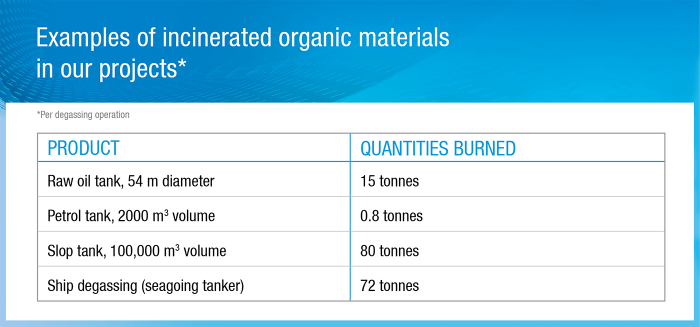Die Zukunft ist heute.
Blog / News / Aktuelles
“My mission: lower emissions.”

It’s one of those subjects that have preoccupied governments, business and the press year after year – emissions reduction. What for some people is a desirable but perhaps abstract goal, has dominated my life for over a decade. In 2007 I founded ENDEGS and developed the technology for the world’s first mobile degassing system. I was spurred on by the new German Clean Air Act, and by my son. When he was little I taught him how to swim in local ponds without a second thought. The water quality was good, so even if he swallowed a mouthful it was safe. That brought home to me how important good water is for quality of life, and it prompted me to wonder if the same might apply to air. Isn’t good air equally important? And if that is the case, why can we smell refineries before we see them? Can’t we do something about that?
Smart combustion of ammonia
Yes – and ENDEGS is part of it. Our technologies give industry a way to noticeably reduce emissions. So that more and more industries and thus all of us can benefit from this, my team and I are constantly researching and developing, and extending the applications of our technologies. For example, now we’ve made it possible to incinerate even ammonia. Why the “even”? Because ammonia is a real challenge. It doesn’t burn evenly, but in bursts and explosively. But our highly intelligent combustion process can easily deal with these characteristics, so that in our degassing systems ammonia burns with extremely low emissions and almost residue-free.
Emissions reduction technology has come a long way. Unfortunately, it’s still not used anything like as rigorously as it should be.
Critical special cases
When stationary emissions-reduction systems fail, too often vapours are simply vented into the air until the system has been repaired. This releases large amounts of toxic materials – tonnes each day – into the environment, poisoning the air for people and nature. Yet it would be so simple to avoid this. We have a solution that can reduce almost to zero the amount of waste released.

Caption: Example of ENDEGS emissions reduction with a substitute VRU unit – mobile, autonomous, safe.
Rethinking – an evolutionary process
But much has been done in this country over the past few decades to improve air quality. In the beginning our degassing units were viewed sceptically or even seen as safety hazards, but now we get many of our orders because just the opposite is the case – our technologies provide more safety. They protect the environment and protect employees. Because a substance that is not emitted can do no harm. Our customers’ employees can feel the difference. Literally – even near the tanks, they can go without masks without risk. Another important driver is surrounding neighbourhoods. People have started to react sensitively to industrial odours, which are seldom harmless and never healthy. The days when smoke pouring out of smokestacks was welcomed as a symbol of prosperity are over.
People need the planet. Not the other way around.
What’s more, there has been a generational change in industry, and with it a change in thinking, slow though it may be. Gradually more and more decision-makers are starting to become aware of the importance of the environment, and of the fact that protecting the environment doesn’t come for free. Many companies have formulated environmental directives, but here again rigorous implementation is the key. Because one thing is clear – people need the planet. Not the other way around. So all of us have a responsibility to treat it well, and enable our children and coming generations to have a liveable future. A future in which industrial odours have only good associations. Like in late summer when the smell of freshly harvested hops wafts over our headquarters near Ingolstadt. That’s something I have nothing against!
Kai Sievers
Cookie Consent
This website uses cookies and similar functions to process end device information and personal data. The processing serves to integrate content, external services and elements from third parties, statistical analysis/measurement, personalized advertising and the integration of social media.Depending on the function, data is passed on to third parties and to third parties in countries in which there is no adequate level of data protection and is not processed by them, e.g. e.g. the USA.
Your consent is always voluntary, not required for the use of our website and can be rejected or revoked at any time using the button at the bottom right.
More information can be found here > Privacy & Cookies Policy
Accept all Reject
Cookie settings
Privacy Overview
| Cookie | Duration | Description |
|---|---|---|
| _security_* | 1 day | This cookie is set by the WP Cerber Security Plugin and is used to differentiate between the different user types and the associated protection against bots. |
| cookielawinfo-checkbox-necessary | 1 year | This cookie is set by the GDPR Cookie Consent Plugin and is used to record the user's consent to the cookies of the "Necessary" category. |
| CookieLawInfoConsent | 1 year | Records the default button state of the corresponding category & the status of CCPA. It works only in coordination with the primary cookie. |
| Cookie | Duration | Description |
|---|---|---|
| _ga | 2 years | The _ga cookie, installed by Google Analytics, calculates visitor, session and campaign data and also keeps track of site usage for the site's analytics report. The cookie stores information anonymously and assigns a randomly generated number to recognize unique visitors. |
| _ga_* | 2 years | This cookie is installed by Google Analytics. |
- Why ENDEGS
- Markets & Applications
- Technologies & Services
- Dependability & Sustainability
- Blog
- Locations & Contact
